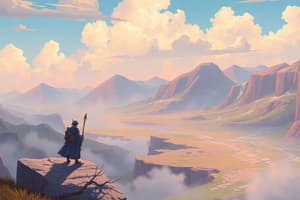Podcast
Questions and Answers
What is the primary function of copyright?
What is the primary function of copyright?
- To allow free use of any artistic work
- To grant exclusive rights to the creator (correct)
- To simplify the distribution of ideas
- To promote public domain works
Which of the following is an example of patented invention?
Which of the following is an example of patented invention?
- A popular song
- A movie script
- A novel character in a book
- The design of a unique chair (correct)
What does fair use allow a person to do?
What does fair use allow a person to do?
- Sell copyrighted works without permission
- Copy any material without restrictions
- Use copyrighted material for criticism or commentary (correct)
- Distribute material as long as it's for profit
What distinguishes a trademark from other intellectual property?
What distinguishes a trademark from other intellectual property?
What is the definition of plagiarism?
What is the definition of plagiarism?
Which of the following best defines cyberbullying?
Which of the following best defines cyberbullying?
What does 'digital addiction' refer to?
What does 'digital addiction' refer to?
What is meant by the 'digital divide'?
What is meant by the 'digital divide'?
What is the primary purpose of non-text elements in educational materials?
What is the primary purpose of non-text elements in educational materials?
Which type of writer focuses mainly on personal opinions and social issues in their articles?
Which type of writer focuses mainly on personal opinions and social issues in their articles?
How do authors differ from writers?
How do authors differ from writers?
What role does a data encoder primarily fulfill?
What role does a data encoder primarily fulfill?
Which of the following is NOT a responsibility of an editor?
Which of the following is NOT a responsibility of an editor?
What distinguishes a contributor from a regular writer?
What distinguishes a contributor from a regular writer?
What is the main focus of the layout and graphic artist in the writing process?
What is the main focus of the layout and graphic artist in the writing process?
Which statement is true regarding the role of publishers in the content creation process?
Which statement is true regarding the role of publishers in the content creation process?
Flashcards
Intellectual Property
Intellectual Property
Output of intellectual pursuits (e.g., literary works, inventions, logos).
Copyright
Copyright
Rights granted to creators to restrict copying, redistribution, and changes to their work.
Copyright Infringement
Copyright Infringement
Unauthorized use or copying of copyrighted material.
Patent
Patent
Signup and view all the flashcards
Trademark
Trademark
Signup and view all the flashcards
Fair Use
Fair Use
Signup and view all the flashcards
Plagiarism
Plagiarism
Signup and view all the flashcards
Netiquette
Netiquette
Signup and view all the flashcards
Author
Author
Signup and view all the flashcards
Writer
Writer
Signup and view all the flashcards
Contributor
Contributor
Signup and view all the flashcards
Columnist
Columnist
Signup and view all the flashcards
Blogger
Blogger
Signup and view all the flashcards
Data Encoder
Data Encoder
Signup and view all the flashcards
Layout/Graphic Artist
Layout/Graphic Artist
Signup and view all the flashcards
Editor
Editor
Signup and view all the flashcards
Study Notes
Intellectual Property
- Pertains to creations of the mind, including literary, artistic, and inventive works, logos, symbols, and commercial names/images.
Copyright
- Grants authors exclusive rights to restrict copying, redistribution, and adaptation of their work.
- Protects various media; printed materials (books, scores, maps), artworks (paintings, sculptures), and images/drawings are included.
Copyright Infringement
- Violation of copyright laws.
Patents
- Legal protection granted by a government to inventors.
- Provides exclusive rights to the inventor for a set period.
- Requires a complete disclosure of the invention.
- Thomas Edison (light bulb, phonograph, camera) and Alexander Graham Bell (telephone) are examples of inventors.
Trademarks
- Distinctive signs associated with specific brands of goods or services.
Fair Use
- Allows the use of copyrighted material for comment, criticism, review, or parody without permission from the copyright owner.
Plagiarism
- Using someone else's words or ideas without giving credit.
Netiquette
- Good online etiquette for emails, forums, blogs, and social media.
- Guidelines include thoughtful consideration, kindness, respectful language, discretion, and respecting privacy.
Cyberbullying
- Bullying using electronic technology.
Digital Addiction
- Excessive use of technology (Facebook, Twitter, etc.) that interferes with daily life.
Digital Divide
- Inequality in access to information and communication technology.
Text Information & Media
Text Information
- Can be written in various scripts (Roman alphabet, Japanese, Chinese, Korean, etc.).
Non-Text Elements
- Books for younger readers often include images for understanding.
- Books for older readers might include charts, graphs, etc., that support the text.
Creators of Text Information
- Writers/Authors create and shape the written word, impacting readers.
- A variety of roles contribute to the production of a quality work.
Types of Writers
- Author: Typically works on longer pieces, like novels.
- Writer: Primarily focused on literary works.
- Contributor: Writes on specific themes, with limited space/theme constraints.
- Columnist: Writes opinion pieces on political/social issues (regular columns).
- Blogger: Shares personal opinions and reflections.
- Data Encoder: Converts handwritten text into digital format.
- Layout & Graphic Artist: Designs the visual aspects of the publication.
- Editor: Reviews content and format for accuracy and consistency.
- Publisher: Manages the publication process (role not fully detailed).
Studying That Suits You
Use AI to generate personalized quizzes and flashcards to suit your learning preferences.




